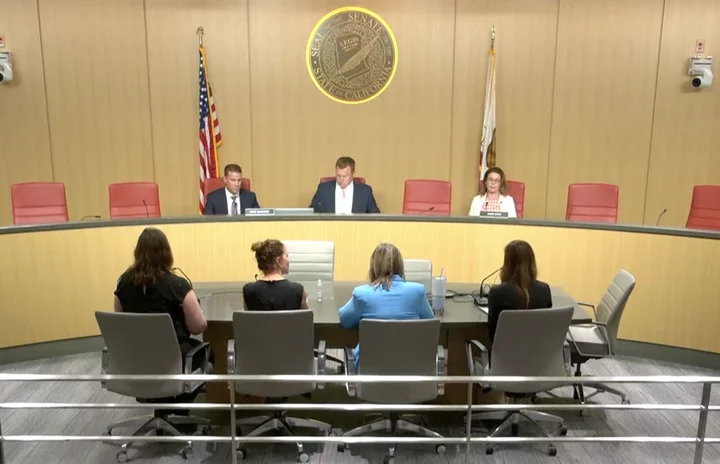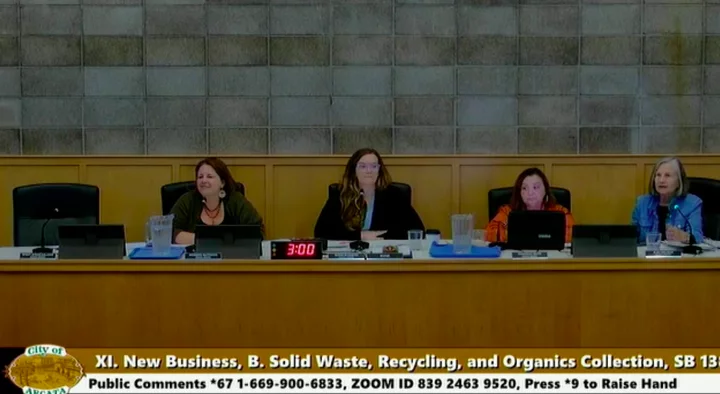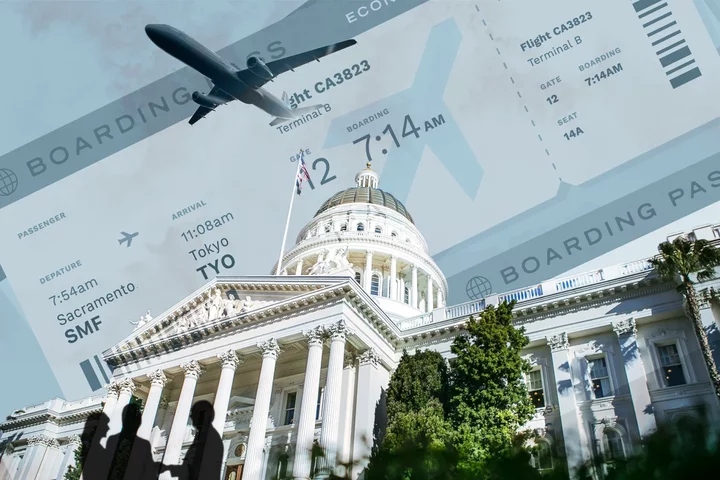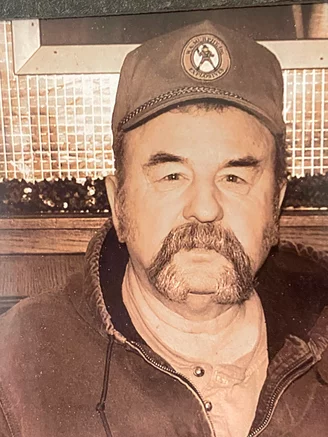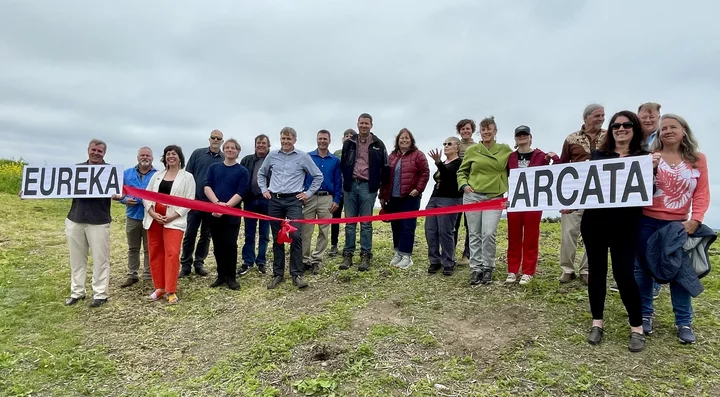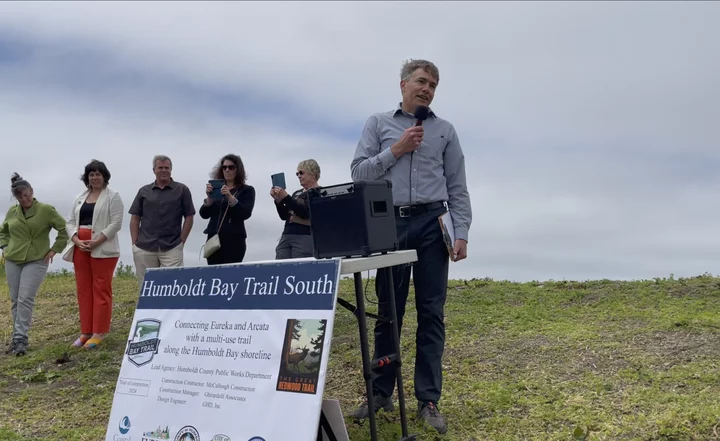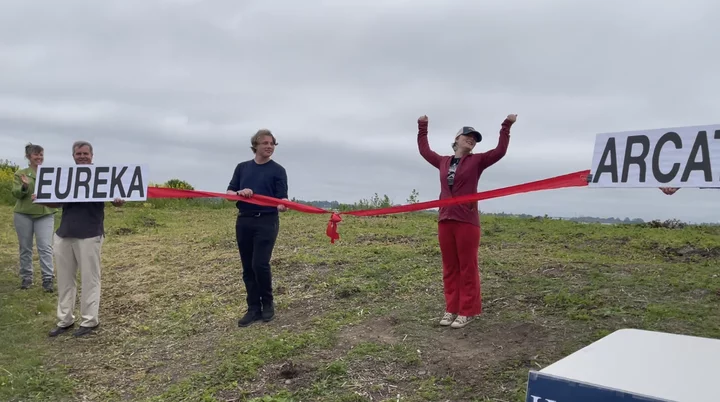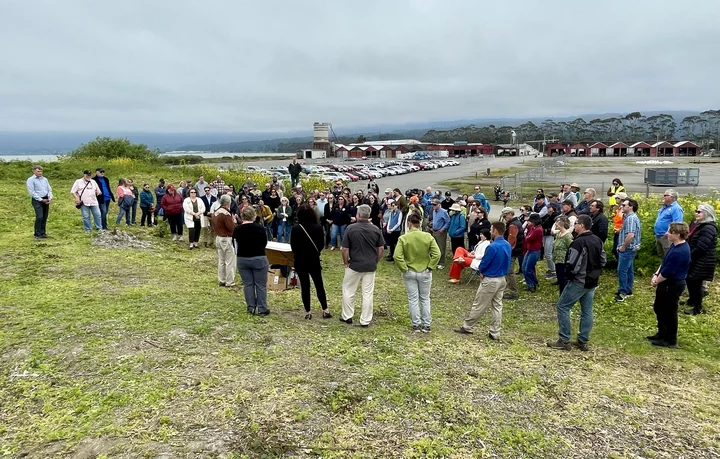Mike McGuire Says We’ll Need to ‘Move Heaven and Earth’ to Expedite Floating Offshore Wind Development, Hears Concerns From Commercial Fishermen and Environmentalists
Isabella Vanderheiden / Thursday, May 18, 2023 @ 3:47 p.m. / Energy , Offshore Wind
Screenshot of Wednesday’s Joint Committee on Fisheries and Aquaculture hearing at the state capitol. Screenshot.
###
State Senate Majority Leader Mike McGuire, Chair of the Joint Committee on Fisheries and Aquaculture, held a hearing on Wednesday afternoon to discuss next steps with floating offshore wind development along the West Coast and to explore strategies to enhance coastal environmental protections while also protecting the interests of California’s fishing fleet.
“As we all know, the Golden State is staring down some extraordinary deadlines to meet our climate goals, and power generation plays a massive role in achieving these goals,” McGuire said during Wednesday’s hearing. “If we are serious about meeting these deadlines, we’re going to have to move heaven and earth to deploy new green power generation facilities in every corner of the Golden State.”
Late last year, the Bureau of Ocean Energy Management (BOEM) auctioned off five leases – two off Humboldt Bay and three off Morro Bay – totaling nearly 600 square miles for the development of floating offshore wind energy facilities. The lease auction was the first of its kind on the West Coast and a critical component in furthering the Biden-Harris administration’s goal of deploying 30 gigawatts (GW) of offshore wind energy by 2030 and 15 GW of floating offshore wind energy by 2035.
The future site of the floating offshore wind farm. Map: BOEM
BOEM finalized and executed the lease agreements just this week, but there’s still a long way to go – perhaps another ten years – before the floating turbines start spinning off of our shores.
“The very first thing that’s due [next] are the communication plans,” said Jen Miller, BOEM’s chief of the Renewable Energy Section for the Pacific Region. “We will have a communications plan for the fisheries, Native American tribes, [as well as federal and state] agencies. I would say the first thing to get right are those communications plans … making sure that they’re robust, they’re thoughtful, and that they consider all of the needs … of those groups that are resource-constrained. How do we make sure that that engagement is as regular as needed, but not overbearing?”
Yurok Tribal Vice-Chair Frankie Myers expressed his appreciation to federal and state representatives “for simply including tribes and making sure that we were heard and included in [this] conversation.”
“I think that’s absolutely the right first step that we have to take [while] looking at the potential for offshore wind here in California,” he said. “From my perspective – from the Yurok perspective – we view the world around us as a part of who we are, that we are a part of the world around us. … We look towards our past to help guide us into our future and I think it’s critically important that we continue that same methodology as we look at offshore wind.”
The communication plans are due in the next three months. Once those are complete, various agencies and environmental entities will begin a survey and data collection process to better inform the design and layout of the wind farms.
One of the biggest concerns that has cropped up around the development of offshore wind is its potential impact on marine ecosystems. Miller noted that BOEM’s environmental studies program has already done “quite a bit of work on marine mammals and entanglement studies for floating offshore wind,” but acknowledged that they “need to do more [research] that is specific to the West Coast.”
“One of the studies that has really received a lot of traction was the entanglement study that looks at potential entanglement risk due to potential floating cables that will connect wind turbines here in the Pacific [to the sea floor],” she continued. “That was identified as a potential risk. … And then we do have marine mammal mitigations that have been in place for our Atlantic leases [which] include a lot of passive acoustic monitoring for activities that are occurring on vessels and in the ocean.”
Garry George, director of the Clean Energy Initiative at the National Audubon Society, also underscored the importance of protecting birds.
“Just in terms of science, I want to remind you that Audubon’s 2019 study, [“Survival by Degrees: 389 Bird Species on the Brink”], reveals that if warming gets to 3º Celsius above pre-industrial levels, we may lose 389 species of North American birds. … We support rapid deployment to get to 100 percent clean energy as fast as possible. … In order to protect the California marine resources that are on and above the water – that would be birds and bats – the state of California needs to ensure that the siting and operation is informed by good collaborative independent science.”
Commercial fisheries are at risk as well. Mike Conroy, West Coast director for the Responsible Offshore Development Alliance, acknowledged that impacts to the industry are likely inevitable but said, “the scale of those impacts remains unknown.”
“Can offshore wind and fisheries coexist?” he asked, repeating the question posed on the agenda. “I appreciate the question as our coexistence is presumed. The fishing industry has some serious concerns. … We have been asking BOEM to slow down the process, build out the five lease areas and let them operate so we can actually see what the impacts will be. If offshore wind will wreak havoc on the form and function of California’s marine ecosystem, then we need to stop it.”
When “unavoidable” and “unmitigated” impacts are identified and better understood, “compensating impacted community members should be a priority,” Conroy added.
Speaking on behalf of the committee, McGuire emphasized the importance of a statewide approach rather than a port-by-port approach for lost fishing grounds.
“There is going to have to be some type of mandatory compensation for lost fishing ground,” he said. “We know that this climate crisis has impacted the fleet as we see a shorter Dungeness crab season … and they’re struggling. We’re going to need to be able to work with offshore wind to ensure that they’re gonna continue to thrive. … Same thing with California’s iconic salmon fleet.”
“I think we’re going to have to be able to come together to figure out how both [offshore wind and commercial fisheries] are going to coexist,” he added.
###
PREVIOUSLY:
- Biden Administration Proposes Offshore Wind Lease Sale, Including Two Spots Off the Humboldt County Coast
- IT’S ON: Humboldt Offshore Wind Leases to Go Up For Auction on Dec. 6
- Harbor District Announces Massive Offshore Wind Partnership; Project Would Lead to an 86-Acre Redevelopment of Old Pulp Mill Site
- Offshore Wind is Coming to the North Coast. What’s in it For Humboldt?
- North Coast Fishermen Fear for the Future of Commercial Fisheries as Offshore Wind Efforts Advance
- North Coast Tribes Advocate for ‘Meaningful, Impactful Partnership’ with Potential Developers Ahead of Tomorrow’s Highly Anticipated Offshore Wind Lease Auction
- ‘Together We Can Shape Offshore Wind for the West Coast’: Local Officials, Huffman and Others Join Harbor District Officials in Celebrating Partnership Agreement With Crowley Wind Services
- SOLD! BOEM Names California North Floating and RWE Offshore Wind Holdings as Provisional Winners of Two Offshore Wind Leases Off the Humboldt Coast
- ‘It’s Beyond Frustrating’: Yurok Vice-Chair Calls Out Provisional Winners of Offshore Wind Bid for Failing to Engage With the Tribe Aheads of This Week’s Auction
- California’s Aging Electrical Infrastructure Presents Hurdle for Offshore Wind Development on the North Coast
BOOKED
Yesterday: 5 felonies, 13 misdemeanors, 0 infractions
JUDGED
Humboldt County Superior Court Calendar: Today
CHP REPORTS
5500 Mm101 N Men 55.00 (HM office): Assist with Construction
Us101 S / Jordan Rd Ofr (HM office): Traffic Hazard
2427 Mm3 S Tri 24.30 (RD office): Trfc Collision-No Inj
ELSEWHERE
RHBB: Ishi Pishi Road Closed October 14-20 for Culvert Replacements
RHBB: Voyage to the Galápagos Explores How Ocean Nutrients Sustain Life
RHBB: ‘Be Prepared for the Rain, Protect the Storm Drain!’ — City of Arcata
MORE on the COMPOST MANDATE: Arcata City Council Moves Forward With Recology Franchise Agreement; Curbside Pickup of Organic Waste Expected to Roll Out in 2025
Stephanie McGeary / Thursday, May 18, 2023 @ 3:18 p.m. / Local Government
Arcata City Council members (from left) Meredith Matthews, Sarah Schaefer, Kimberly White & Alex Stillman (Stacy Atkins-Salazar absent) | Images: screenshots from online meeting video
PREVIOUSLY
- Humboldt Prepares for California’s Extensive Organic Waste Bill That Will Require Us to Start Composting, Among Other Things
- Arcata City Council Introduces Ordinance That Will Mandate Composting Your Food Scraps (By Yourself, or Through a Service) to Comply With State’s Organic Waste Bill
- Arcata City Council Adopts Revised Budget, Approves Agreement With HWMA for Composting Organic Waste
- Ready to Compost Yet? Arcata City Council to Discuss Agreement with Recology for City-Wide Curbside Pickup Service for Organic Waste
###
It’s time to start thinking about composting (if you don’t already) because soon the City of Arcata will require curbside pickup for organic waste to bring the city into compliance with California’s Short-Lived Climate Pollutant Reduction Strategy, SB 1383.
Okay, so it will probably be a couple of years before Arcata actually rolls out the composting service. But on Wednesday night the Arcata City Council (minus Councilmember Stacy Atkins-Salazar, who was absent) took one of many steps needed to begin citywide composting by authorizing city staff to draft a franchise agreement with Recology for the service.
Emily Benvie, Arcata’s deputy director of environmental and community services, began by giving the council some background on the city’s current franchise agreement with Recology, which expires in 2029. Currently Recology provides universal curbside collection for trash, recycling and green waste – which includes yard waste, but not food scraps or other compostables. In exchange for being the City’s service provider, Recology gives the City 10 percent of its revenue as a “franchise fee,” Benvie said. This comes to approximately $400,000 annually, which the city puts toward street repair (to offset the wear and tear from Recology’s trucks) and toward other city cleanup programs such as park cleanups and graffiti removal.
In addition to adding organic waste pickup service, the new franchise agreement will address other aspects of waste management, including the bulky item pickup offered to residents, the frequency of pickup service, providing additional small kitchen food scrap bins for residents and education and outreach about the services.
The different components of SB 1383 that Arcata must undertake
Of course there is the issue of rate increase and the bad news, Benvie explained, is that Recolgy is already anticipating raising its rates just to maintain its current level of service. Recology transports waste to the Eureka Transfer Station (aka, the dump) operated by the Humboldt Waste Management Authority (HWMA), which estimates a 26 percent increase in tipping fees – the fees that waste management facilities have to pay to put waste into the landfill. HWMA is also increasing its processing fees by about 57 percent, Benvie said.
This means that Recology will have to pay more money to HWMA and, in turn, residents will need to pay more to Recology. Benvie said that the average rate increase will be about four dollars per household per month for the current services that Recology provides. How much people will have to pay additionally for the organic waste pickup is still unclear, Arcata City Manager Karen Diemer said, but staff anticipates about an additional 30 percent increase in costs.
The agreement will also carve out a space for the businesses already providing organic waste pickup, which includes Local Worm Guy and Full Cycle Compost. Under the new agreement, these businesses will be permitted to process up to 10 percent of the city’s organic waste and residents who already pay for those services will be able to opt out of the citywide compost pickup.
However, since the way SB 1383 is written requires residents to use a curbside pickup service, there will likely not be an option for residents and businesses who do their own composting to opt out of the service.
During public comment several community members expressed concern over the fact that people who do their own composting will still have to pay for the curbside collection. “I compost [at home]…Everything I compost can go in my garden,” one commenter said to the council. “It’s really sad that there’s no option for us, that we’re mandated to do something that we don’t need to do.”
Under the new service Recology will likely allow yard waste and food scraps to be combined into one green bin, Benvie explained, so many residents will likely be able to still use the service for their yard waste. Benvie also mentioned that people will be able to place bones and meat in the bins, which some people don’t want to put in their own home compost.
There were also concerns about how the rate increase will disproportionately affect low-income residents. Councilmember Meredith Matthews said she understands that concern and hopes that the city will look at subsidizing costs for low-income people in the future.
The franchise agreement is expected to return to the council for review this fall. Because it will take a while for Recology to make the necessary capital improvements, roll-out of the collection service will not begin until fall 2025. Benvie was clear that the community will receive notice of the rate increases, and that no one will be paying for the organic waste collection until the service begins.
BIOBLITZ! Let’s Catalog All the Plants, Animals and Funguses That Live Around Sequoia Park on Saturday Sunday
LoCO Staff / Thursday, May 18, 2023 @ 2:28 p.m. / Nature
Press release from the Sequoia Park Zoo:
The Sequoia Park Zoo is hosting a FREE bioblitz on Sunday, May 21, 2023. This bioblitz event focuses on finding and identifying as many species as possible on the Redwood Sky Walk and in Sequoia Park.
Participating in a community science bioblitz is a fun way to observe nature, enjoy quality family time, and contribute to real scientific research. This family-friendly event is open to bioblitz beginners and experts. NO previous knowledge is necessary! All participants receive a free nature journal and pencil. This event is part of the Association of Zoos and Aquariums (AZA)’s Party for the Planet.
Beginners meet at the Sequoia Park Zoo at 7 a.m. (with gates closing at 7:15 a.m.) to learn how to install and use three free nature identification apps (iNaturalist, Seek, and Merlin Bird ID) on their own phone.
Those with experience using the apps can arrive at 8 a.m. (with gates closing at 8:15 a.m.) for the orientation and beginning of the bioblitz on the Redwood Sky Walk. The bioblitz will occur from 8 a.m. to 12 p.m., but participants can leave at any time.
Attendance is limited, and participants must RSVP for free at this link.
All participants must sign a liability waiver. While all ages are welcome, children 15 years old and younger must be accompanied by an adult guardian. The bioblitz is held in ADA-accessible areas, though some participants may venture into areas that are not accessible. Starting now, anyone can contribute to this bioblitz on iNaturalist by joining the project “Sequoia Park Zoo bioblitz 2023.”
What: Sequoia Park Zoo Bioblitz
When: Sunday, May 21, 2023 from 7 a.m. to 12 p.m. PT
Where: Sequoia Park Zoo, 3414 W Street, Eureka, CA 95503
What to Bring: smart device compatible with the apps, clothing appropriate for the weather, shoes or mobility gear for trail use, water bottle if desired
This Law Should Reveal Who’s Paying for California Legislators’ Travel. It’s Only Been Used Twice
Alexei Koseff and Jeremia Kimelman / Thursday, May 18, 2023 @ 7:26 a.m. / Sacramento
Illustration by Miguel Gutierrez Jr., CalMatters; iStock
After years of controversy over state legislators taking trips paid by interest groups, California in 2015 adopted a law intended to bring more transparency to sponsored travel.
Senate Bill 21 requires trip organizers to annually disclose any major donors who travel alongside elected officials, taking aim at the secrecy that often surrounds these policy conferences and international study tours.
Yet in the seven years since the law took effect, disclosure forms have been filed for only two events — despite legislators reporting millions of dollars in sponsored travel and dozens of trips during that period. One form was filed last year and the second only after CalMatters made inquiries.
It’s unclear exactly why the disclosure has been such a failure.
Former state Sen. Jerry Hill, the San Mateo Democrat who pushed for the law, said he was surprised by its infrequent use. He said he crafted qualifications that he believed major travel sponsors would easily meet, requiring them to share more information with the public about who is paying for legislators’ travel — but, in hindsight, the language about when they have to file may not have been specific enough.
Many groups, including two whom Hill cited in arguments for the law, contend that they do not meet the eligibility criteria laid out in the measure, even as they spend tens of thousands of dollars or more to take legislators to far-flung locations.
“It looks like it’s being interpreted in the most favorable light for the nonprofits, and they are looking at that as a way of getting around it,” Hill told CalMatters.
If that is the case, he added, legislators should update the language to ensure the intent is clear.
“It’s frustrating,” he said. “It is law and it should be followed. And it’s disappointing that some have used whatever reason they can find to not follow the law.”
If any organizations are out of compliance, the state’s political ethics watchdog, which is responsible for enforcement, cannot say. The Fair Political Practices Commission has never clarified potentially ambiguous language in the rules and it depends on filers to follow them, investigating primarily if it receives a complaint. None has ever been lodged.
Jay Wierenga, a spokesperson for the commission, wrote in an email that he did not know the specifics of the situation, but “in my experience most of the folks who deal with this are sophisticated enough and/or smart enough to follow the rules and hire legal counsel to make sure they’re following it.”
Different rules for trip sponsors
California law allows elected officials to accept unlimited free travel from a nonprofit organization, as long as the trip is related to policy issues or they are giving a speech or participating on a panel. Officials must report the travel as a gift on their annual statements of economic interest filed with the Fair Political Practices Commission — and, because of the same 2015 law, disclose the destination.
But the nonprofits — often funded by corporations, unions and industry associations that lobby the Legislature and the state — do not have similar reporting requirements. Though some voluntarily share lists of donors, they are not obligated to reveal how much money they receive and from whom.
For nearly as long as these trips have been happening, they have generated criticism from opponents who believe they amount to unofficial lobbying, allowing interest groups to buy privileged access to lawmakers and regulators away from public scrutiny.
 /
/Then-Sen. Jerry Hill speaks in the state Capitol. Photo by Anne Wernikoff for CalMatters
Hill said he grew more concerned after the 2010 PG&E pipeline explosion in his district that killed eight and destroyed a San Bruno neighborhood, which led to revelations about then-California Public Utilities Commission President Michael Peevey’s close relationship and extensive travel with companies regulated by the commission.
So the law Hill authored was meant to provide greater accountability for which interest groups are paying for travel and how these trips can serve as opportunities for influence-peddling. It requires “a nonprofit organization that regularly organizes and hosts travel for elected officials” to annually report any donors who gave more than $1,000 and also accompanied elected officials on any portion of a trip, if the group meets two criteria:
- Travel gifts to elected officials in that year totaled more than $10,000, or at least $5,000 to a single official.
- Spending for travel, study tours and conferences, conventions and meetings related to elected officials account for at least one-third of its total expenses, as reflected in its federal tax filings.
Over the past two years, 16 organizations exceeded the first threshold at least once, according to a CalMatters analysis of legislators’ statements of economic interest. Just two of them filed the travel sponsor disclosure, known as Form 807.
The California Problem Solvers Foundation, which supports a bipartisan legislative caucus, revealed that in 2021, the year it launched, representatives from the California Medical Association, Edison International, the Associated Builders & Contractors of California, PhARMA, Blue Shield of California, DaVita Inc., PG&E and Sempra Energy donated and attended its inaugural policy summit in Dana Point, alongside nine lawmakers.
The foundation, however, did not file the form again for last year, when it spent another $12,000 taking four legislators to a policy summit in Sonoma. A spokesperson, Nick Mirman, declined to comment.
The California Legislative Jewish Caucus Leadership Foundation, which spent more than $213,000 to take 14 legislators to Israel in July, said it wrongly forgot to submit a disclosure for the trip.
After CalMatters reached out, a representative for the foundation said its compliance attorneys discovered the error while completing its taxes. She provided a Form 807 that the foundation planned to file, showing two donors that also traveled to Israel: the Koret Foundation Donor Advised Fund at Stanford University and the Jewish Federation of Los Angeles. The Fair Political Practices Commission confirmed Wednesday that it received the form.
Over the last week, CalMatters surveyed the 14 other groups about why they did not file the disclosure form.
- Three asserted they did not meet the eligibility requirements of the law, but did not specify how in follow-up inquiries: the Governor’s Cup Foundation, which organizes an annual golf tournament in Pebble Beach; the Shared Energy Future Foundation, the charitable arm of the oil and natural gas industry; and The Climate Registry, which spent more than $37,600 to bring lawmakers to United Nations climate conferences in Scotland and Egypt over the past two years.
- Two said they are trade associations, which are exempt from the law: the Association of California Life and Health Insurance Companies and the California Independent Petroleum Association.
- Five did not respond to questions, despite repeated inquiries: the California Biotechnology Foundation, the California Latino Legislative Caucus Foundation, the Climate Action Reserve, the Council of State Governments-West and the Foundation for California’s Technology and Innovation Economy.
- The California Environmental Voters Education Fund suggested that five lawmakers had incorrectly reported the organization as the sponsor of their travel to a United Nations biodiversity convention in Montreal, saying it had raised the money from another group called the Resources Legacy Fund.
Ambiguity in the law
A possible issue is how broadly to construe “activities with regard to elected officials,” as the law states, when determining expenses for the one-third of total spending threshold. Hill said his intent was for that calculation to cover the entire cost of trips and conferences attended by legislators, but nonprofits may be counting only their direct payments to lawmakers.
“Hindsight is 20/20, and if the nonprofits are using that as a way around following the law, that needs to be clarified or it needs to be enforced in a way that requires them to follow the law,” Hill said.
Wierenga said the Fair Political Practices Commission has no formal advice about how to complete the form because “nobody files them, so we’ve apparently never really been asked.”
Two prominent organizations mentioned by Hill at the time as inspirations for the 2015 law — the California Foundation on the Environment and the Economy and the Independent Voter Project — told CalMatters they had never met the one-third of expenses threshold.
The California Foundation on the Environment and the Economy, which sends lawmakers to policy conferences across the state and on international study tours, is by far the biggest source of sponsored travel that lawmakers annually report. In 2022, the foundation accounted for about 40% of the nearly $1 million in trips that California legislators took, according to a CalMatters analysis published this month.
A tax filing for last year is not yet publicly available. But in 2019, for example, the foundation reported spending $423,114 on study travel projects and $385,949 on conferences, conventions and meetings — about 43% of its nearly $1.9 million in expenses. Other recent years have comparable figures.
Spokesperson PJ Johnston declined to explain how the foundation calculates its expenses under the criteria laid out by the disclosure law. In an email, he wrote that “your approach may not take into account the full provisions,” but did not elaborate.
“Addressing your ‘calculations’ is not our responsibility, that is not our burden,” he wrote. “Your ‘calculations’ are imbued with no official weight, verification or concurrence from any agency with jurisdiction.”
He added that the foundation has never received any questions or guidance from the Fair Political Practices Commission about the disclosure law.
“It’s frustrating. It is law and it should be followed. And it’s disappointing that some have used whatever reason they can find to not follow the law.”
— Former state Sen. Jerry Hill, who pushed for the transparency law
Each November, the Independent Voter Project organizes a conference where dozens of legislators and corporate sponsors gather for a week of policy discussions and schmoozing at a luxury hotel in Maui. The event has long been a lightning rod for concerns about the close relationship between lawmakers and interest groups that have business before the Legislature.
Last year, the nonprofit spent $38,856 to bring 13 legislators to the Maui conference. But Dan Howle, the chairperson and executive chairman, said that event is a small fraction of the Independent Voter Project’s work — which also includes public education on the rights of no party preference voters and court challenges to laws restricting the participation of these voters in primary and general elections.
On its 2021 tax filing, the most recent that is publicly available, the Independent Voter Project reported spending $169,530 on conferences, conventions and meetings and $43,372 on travel and entertainment payments for public officials — just under a quarter of its $882,122 in total expenses for that year. Travel accounts for another $384,614 in spending, though it’s unclear whether those costs relate to “activities with regard to elected officials.”
Howle said the costs for the Maui conference — which include a dinner at the hotel restaurant, opening and closing receptions and the sponsored travel for legislators — are not as much as they may seem. His organization does not count hotel rooms for sponsors, which they pay for as part of their registration, curtailing spending that would qualify for the one-third threshold.
“We haven’t felt required to report it because we don’t reach that threshold,” Howle said. He said that the Independent Voter Project came to that conclusion after discussing the law with the Fair Political Practices Commission the year it took effect. The commission has issued no official advice.
A third organization, the California Issues Forum, also maintains that it hasn’t filed the form because it hasn’t spent enough to cross the disclosure threshold. Chris Tapio, a spokesperson, wrote in an email that the nonprofit’s “activities and expenditures have not met the statutory criteria” for filing a report.
The organization spent $15,634 to take 15 legislators to Napa, Los Angeles, and Marina Del Rey in 2022, according to lawmakers’ statements of economic interest, and $13,454 to take 13 legislators to La Jolla, Monterey and Lafayette in 2021.
Tax returns for those years are not yet publicly available. But in 2019, the organization reported spending $323,032 on conferences, conventions and meetings, and $15,072 on travel, accounting for about 27% of its nearly $1.3 million in expenses.
Yet in a separate category of the 2019 tax form, the California Issues Forum reported that it spent more than $1 million that year for seminars, meetings, and conferences that “brought experts, speakers and legislators together to educate each other on current issues” — or more than 80% of its total expenses.
Tapio said “that amount is inclusive of many expenses not pertinent to Form 807, such as grants, salaries, and postage.” He did not clarify what spending California Issues Forum does count under the disclosure law.
###
CalMatters.org is a nonprofit, nonpartisan media venture explaining California policies and politics.
OBITUARY: Richard Roy Rollins, 1965-2023
LoCO Staff / Thursday, May 18, 2023 @ 6:56 a.m. / Obits
Richard Roy Rollins passed away in his home on April 27, 2023 after a
hard-fought battle with pancreatic cancer. Rick was a
sixth-generation Humboldt County resident born February 14, 1965 in
Garberville. He was related to early settlers of the Mattole Valley
and surrounding areas.
Rick attended school in Fortuna and attained his GED in 1981. He met his wife, Kim, in 1987 and they later married in 1992. Together they had two children, Levi and Taylor, whom they raised in Honeydew until later buying a home in Carlotta in 2002.
Rick worked many jobs until he found his passion being a farm manager and master grower in the cannabis industry. This career later took him and his wife Kim on an adventure to Oklahoma for 13 months. He was a hard worker who rarely took a day off, even through chemotherapy and other health issues. Rick loved hunting, fishing, mounting biking, going to sporting events and spending time with family and friends at the beach cabin.
Rick is preceded in death by his father, Hollis Rollins Jr; grandparents Paul and Anne Smith, and Hollis and Mod Rollins; uncles Larry Smith and Bud Rollins.
Rick is survived by his wife, Kim Rollins; children, Levi Rollins and Taylor Rollins; mother, Jeanne Rollins; sister and brother-in-law Cindy Carter and Frank Carter; aunt and uncle Linda and Bill Franklin; and numerous step-siblings, half-siblings, nieces, nephews and cousins.
A celebration of life is to be held on June 24, 2023 at 12 p.m. at the Mattole Grange: 36512 Mattole Rd, Petrolia. All family and friends are invited and welcome. This will be a potluck-style event and we would ask attendees to please bring a side dish or dessert if able.
###
The obituary above was submitted on behalf of Rick Rollins’ loved ones. The Lost Coast Outpost runs obituaries of Humboldt County residents at no charge. See guidelines here. Email news@lostcoastoutpost.com.
OBITUARY: Daniel J. Flanagan, 1949-2023
LoCO Staff / Thursday, May 18, 2023 @ 6:56 a.m. / Obits
Daniel J. Flanagan
October 11, 1949 – May 13, 2023
Dan was born October 11, 1949 in Washington D.C. to Daniel J. Flanagan Jr. and Agnes Mae Briggs Flanagan. Dan’s early years were spent between Washington D.C and the family town of Erie, Penn. In August 1953, Dan moved with his family to San Mateo, Calif.
Dan graduated from Serra High School, Class of 1968. After graduation, Dan enlisted in the Air Force, serving four years. While in the service, he married his high school sweetheart, Margie Gantvoort.
Upon discharge from the Air Force, Dan gained employment with PG&E. He was employed with PG&E from March 5, 1963 until retirement November 1, 2014.
Dan was a member of the Redwood Gun Club, Simpson Gun Club (Long Prairie Gun and Archery Club) as well as a Board Member of the Humboldt Trap and Skeet Club.
Dan was an avid outdoorsman and loving father. He enjoyed hunting, fishing, and cutting firewood. He shared his love of the outdoors with his boys; together they made lifelong memories that will be forever cherished. Dan was a family man first and foremost. He lead by example in life; always putting family needs before his own wants and desires. He always made sure the family never did without. He built a strong work ethic in his sons and many of their friends throughout the years, something he was extremely proud of. The door was open to all who came as well as the kitchen: “One rule, don’t eat off my plate!”
Dan is survived his wife of 53 years, Margie; by his three sons, Brian (Amy), Michael (Kelli) and James. He is survived by 10 grandchildren: Lane, Tanner, Brenna, Noel, Jaron, Ace, Brilyn, Rilyn, Mathew and Henry. He is survived by two great-grandchildren: Jasper and Bella. Dan is also survived by his two sisters, Anne Pinkston and Kathleen Benker, and numerous nieces and nephews.
The family would like to thank the following people for walking by Dan’s side through his difficult battle with cancer: Dan’s friends, Dr. Iberri and assistant Kate at Stanford Medical Center, and the entire staff at Providence Health Chemo Infusion Suite. We would like to extend a special thank you to his nurses – Barbara, Ivy, Jade, Jovone – the ones who “drew the short straw.”
Dan was interred at Ocean View Cemetery. A celebration of life will be held at a later date.
###
The obituary above was submitted on behalf of Daniel Flanagan’s loved ones. The Lost Coast Outpost runs obituaries of Humboldt County residents at no charge. See guidelines here. Email news@lostcoastoutpost.com.
Groundbreaking Ceremony Celebrates Start of Construction on Humboldt Bay Trail South, Which Will Finally Connect Eureka and Arcata
Ryan Burns / Wednesday, May 17, 2023 @ 4:52 p.m. / Trails
Eureka City Manager Miles Slattery and Arcata City Manager Karen Diemer (holding signs for their respective cities) celebrate the groundbreaking of Humboldt Bay Trail South with a “ribbon-tying” ceremony, accompanied by a range of stakeholders including state and local officials, community volunteers, businesspeople and others. | Photos by Ryan Burns.
###
After decades of dreaming, planning and lots of work to overcome bureaucratic hurdles, Humboldt County will soon have a paved multi-use trail connecting Eureka and Arcata along the banks of Humboldt Bay.
At a joyous ceremony this afternoon, held atop a berm overlooking the bay from the California Redwood Company sawmill property, state and local officials gathered with community members and other stakeholders to celebrate the start of construction on Humboldt Bay Trail South, a project that will connect the gap between the Eureka Waterfront Trail and the southern terminus of Humboldt Bay Trail North, near the Bracut Industrial Park.
Map of the Humboldt Bay Trail courtesy the County of Humboldt.
###
Leading off the ceremony was Hank Seemann, Humboldt County’s deputy director of public works, who everyone in attendance seemed to agree has been one of the primary driving forces behind the project.
“It has been a long journey to get to this point,” Seemann said, triggering a round of knowing laughter from the assembled crowd.
After noting that everyone was standing on un-ceded Wiyot territory, he went on to note that, until about 25 years ago, most of the shoreline development between Eureka and Arcata was dedicated almost exclusively to cars, the railroad and private industry. But the community had a vision to restore public access to the shoreline while connecting people with each other and the natural world.
That vision has largely come to fruition, Seemann said, thanks to work from employees and officials at the City of Arcata, the City of Eureka and, lately, the County of Humboldt, not to mention “vital support from our community and state partners.”
Hank Seemann addresses the crowd.
###
Construction of the trail is set to begin next month and be completed before the end of 2024. The main contractor is Arcata-based McCullough Construction. Ghirardelli Associates, which has its headquarters in San Jose and an office in McKinleyville, will provide construction management services while international engineering firm GHD, Inc., will provide engineering support.
The cost of construction on this section of trail alone will amount to nearly $20 million, according to Brandon Larson, deputy director for planning and local assistance with Caltrans. Funding has been provided by the California Transportation Commission, the State Coastal Conservancy and Caltrans District 1.
The majority of this new trail segment will be situated between the defunct railroad and Highway 101, while a one-mile portion will be placed atop the levee around the bay side of the Brainard Mill site. This route was made possible thanks to an easement from Green Diamond Resource Company to the county.
Construction will involve widening the railroad prism, major modifications to the Eureka Slough railroad bridge, construction of three new trail bridges and removal of the northernmost stretch of eucalyptus trees along the highway. The project will also entail what the county calls “urgent repairs” to erosion damage along the railroad as well as raising the elevation of the railroad between Brainard and Bracut to address flood hazards.
Fourth District Humboldt County Supervisor Natalie Arroyo speaks into the microphone.
###
“I have to say, being here today, my face hurts from smiling,” said Humboldt County’s Fourth District supervisor, Natalie Arroyo. “This is such an exciting moment.”
She said that, looking around the crowd, she recognized “the faces of so many people who have been essential to making this happen,” including folks she worked with on the Humboldt Trails Council and the Redwood Community Action Agency (RCAA).
“And now here we are today about to build this trail, and I could not be more thrilled,” Arroyo said.
Fifth District Humboldt County Supervisor Steve Madrone, who also serves as the vice-chair of the Great Redwood Trail Agency, said it has been 37 years since RCAA, the County of Humboldt and the state Coastal Conservancy formed a partnership to start looking at trails in this region.
“And it was in 1997 that our first report on possible trail options around the bay was put together,” Madrone said.
First District Supervisor Rex Bohn recalled riding his Schwinn bicycle from Eureka to Arcata to meet up with a girlfriend some 55 years ago. He rode home along Old Arcata Road and said he looks forward to a better route. Bohn also thanked state Senator Mike McGuire and Assemblymember Jim Wood for being “so instrumental” in getting trails built.
Jason Liles, McGurie’s chief of staff, was on hand. He noted that his boss was attending a wind energy hearing in Sacramento and thus, regrettably, could not attend the trail groundbreaking ceremony. He went on to say that in his office there’s a rule that you should only thank elected officials because they get their feelings hurt if you don’t. But in this case, he made an exception.
“I’m just gonna thank one person in particular on behalf of Senator McGuire, and I’d like to see a big round of applause for Hank Seemann,” Liles said, and the crowd complied with enthusiasm.
Caryl Hart, chair of the Great Redwood Trail Agency, emphasized the economic benefits of trails, and she noted that this trail will eventually be part of her agency’s namesake, a planned 320-mile multi-use rail-to-trail project connecting San Francisco and Humboldt bays.
“One of the things that I hear most often is, ‘Will [the Great Redwood Trail] happen in my lifetime?’” Hart said. “I’m so glad that I can say, ‘Go to Humboldt Bay. You will see the Great Redwood Trail as it is being created, as it is connecting around the bay … and that is thanks to all of you.”
Several other folks addressed the assembled crowd. Arcata City Manager Karen Diemer, for example, said, “This is what government looks like when it is following the deep will of your people.”
Eureka City Manager Miles Slattery also commended the broad community collaboration and cracked a joke: “I can’t believe I’m saying this, but I can’t wait for Eureka to be hooked up to Arcata,” Slattery said, getting a big laugh.
Karen Underwood, a board member with the Humboldt Trails Council, said research indicates that when trail gaps between two cities get connected, use of the trails can increase from 40 to 80 percent, but this connection will likely be an outlier.
“After 25 years of waiting Humboldt Trails Council believes that usage of these bay trails will more than double,” Underwood said.
At the conclusion of the ceremony there was a ribbon tying — rather than the traditional ribbon cutting — to emphasize the upcoming new connection between Arcata and Eureka.
Youngsters Asher Bergel (son of Eureka Mayor Kim Bergell) and Nigella Bauer (daughter of Third District Humboldt County Supervisor Mike McGuire Wilson), who was in Washington, D.C.) did the honors, hooking the two ends of the ribbon together, but only after noting that the project has been in the works since before they were born.

